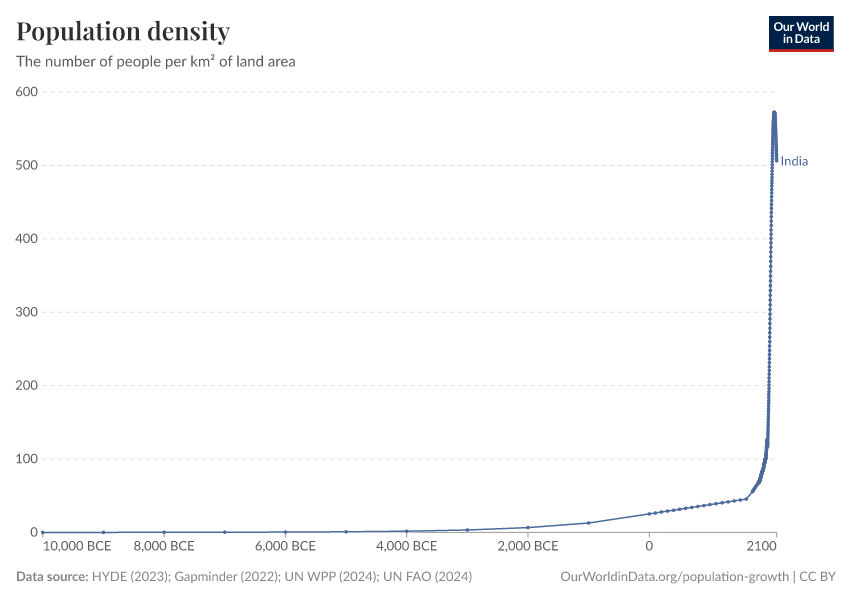Population density

About this data
Related research and writing
About this data
Sources and processing
This data is based on the following sources
How we process data at Our World in Data
All data and visualizations on Our World in Data rely on data sourced from one or several original data providers. Preparing this original data involves several processing steps. Depending on the data, this can include standardizing country names and world region definitions, converting units, calculating derived indicators such as per capita measures, as well as adding or adapting metadata such as the name or the description given to an indicator.
At the link below you can find a detailed description of the structure of our data pipeline, including links to all the code used to prepare data across Our World in Data.
Notes on our processing step for this indicator
We have estimated the population density by using population estimates from multiple sources and land area estimates by the Food and Agriculture Organization of the United Nations.
We obtain it by dividing the population estimates by the land area estimates.
Combination of different sources
We construct our long-run population data by combining multiple sources:
-
10,000 BCE–1799: historical estimates by HYDE (v3.3).
-
1800–1949: historical estimates by Gapminder (v7).
-
1950–2023: population records from the United Nations World Population Prospects (2024 revision).
-
2024-2100: Projections based on Medium variant by the UN World Population Prospects (2024 revision).
Geographical aggregates
- For most years, we calculate aggregates by summing the population of member countries.
- We do this based on our definition of continents and the World Bank’s income groups.
- The only exception is before 1800, where we use HYDE's estimates for continents (but not income groups).
For most of the years, we've estimated regional aggregates by summing the population of countries in each region. We've relied on our continents and World Bank income group definitions. The only exception is before 1800, where we've used HYDE's estimates on continents (but not income groups).
World
- Before 1800: we use data from HYDE.
- 1800-1950: we estimate the global population by summing all available countries in the dataset.
- After 1950, we rely on estimates from the United Nations World Population Prospects.
Reuse this work
- All data produced by third-party providers and made available by Our World in Data are subject to the license terms from the original providers. Our work would not be possible without the data providers we rely on, so we ask you to always cite them appropriately (see below). This is crucial to allow data providers to continue doing their work, enhancing, maintaining and updating valuable data.
- All data, visualizations, and code produced by Our World in Data are completely open access under the Creative Commons BY license. You have the permission to use, distribute, and reproduce these in any medium, provided the source and authors are credited.
Citations
How to cite this page
To cite this page overall, including any descriptions, FAQs or explanations of the data authored by Our World in Data, please use the following citation:
“Data Page: Population density”, part of the following publication: Hannah Ritchie, Lucas Rodés-Guirao, Edouard Mathieu, Marcel Gerber, Esteban Ortiz-Ospina, Joe Hasell, and Max Roser (2023) - “Population Growth”. Data adapted from PBL Netherlands Environmental Assessment Agency, Gapminder, United Nations, Food and Agriculture Organization of the United Nations. Retrieved from https://archive.ourworldindata.org/20250929-103213/grapher/population-density.html [online resource] (archived on September 29, 2025).How to cite this data
In-line citationIf you have limited space (e.g. in data visualizations), you can use this abbreviated in-line citation:
HYDE (2023); Gapminder (2022); UN WPP (2024); UN FAO (2024) – with major processing by Our World in DataFull citation
HYDE (2023); Gapminder (2022); UN WPP (2024); UN FAO (2024) – with major processing by Our World in Data. “Population density” [dataset]. PBL Netherlands Environmental Assessment Agency, “History Database of the Global Environment 3.3”; Gapminder, “Population v7”; United Nations, “World Population Prospects”; Gapminder, “Systema Globalis”; Food and Agriculture Organization of the United Nations, “Land, Inputs and Sustainability: Land Use” [original data]. Retrieved December 20, 2025 from https://archive.ourworldindata.org/20250929-103213/grapher/population-density.html (archived on September 29, 2025).